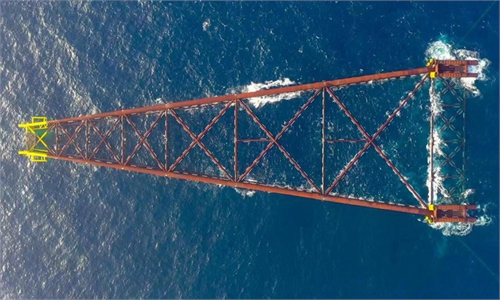China announces discovery of major oilfield in Bohai Sea, with over 100 million tons of proven reserves

China's Bohai Sea Oilfield, the country's largest offshore oil producing base, discovers a third oil field with output of over 100 million tons, China National Offshore Oil Corp announced on March 1, 2023. The field can extract more than 20 million tons of crude oil, which can be refined into enough gasoline for 10,000 small cars to run normally for 30 years. Photo: cnsphoto
China has discovered a major oilfield in the central and northern parts of the Bohai Sea, with proven reserves of 104 million tons of oil, marking a monumental find in the region following a decade of search efforts, state-owned oil giant CNOOC announced on Monday.
The Qinhuangdao 27-3 oilfield, located 200 kilometers west of North China's Tianjin, is a 48.9-meter-thick oil layer in a 1,570-meter-deep well. With reserves exceeding 100 million tons of oil equivalent, testing has shown that the oilfield can produce about 110 tons of crude oil per day, showing promising exploration prospects.
With a regular extraction pace, the Qinhuangdao 27-3 oilfield could produce nearly 20 million tons of crude oil, enough to meet the daily transportation needs of a city with a population of a million people for over a decade. The refined asphalt could be used to build over 100,000 kilometers of four-lane highways, said Zhou Jiaxiong, a manager of CNOOC Tianjin branch.
The discovery of the Qinhuangdao 27-3 oilfield represents a successful practice of the company's new exploration strategy in the Bohai Sea. By changing the existing exploration approach, researchers identified the rich oilfield from a strike-slip fault zone in a complex structure area.
The Qinhuangdao 27-3 oilfield is the sixth 100 million-ton class oilfield discovered in the Bohai Sea since 2019 and the first in the central and northern parts of the sea in a decade, said Xu Changgui, deputy chief exploration engineer at CNOOC.
This discovery not only confirms the vast prospects for oil and gas exploration in the complex strike-slip fault zones of the Bohai Sea but also injects strong momentum into the development of China's offshore oilfields. It will play a significant role in securing China's energy supply and supporting the coordinated development of the Beijing-Tianjin-Hebei region, Xu added.
The discovery of the Qinhuangdao 27-3 oilfield is part of China's ongoing progress in the oil and gas sector, with CNOOC having made significant discoveries in recent years, including the Bozhong 26-6 deep-reservoir oilfield in the Bohai Sea and the Baodao 21-1 gas field in the western South China Sea.
On March 8, CNOOC announced China's first deep-water, deep-reservoir oilfield in the South China Sea, the Kaipingnan oilfield, which has proven reserves of 102 million tons of oil equivalent.



